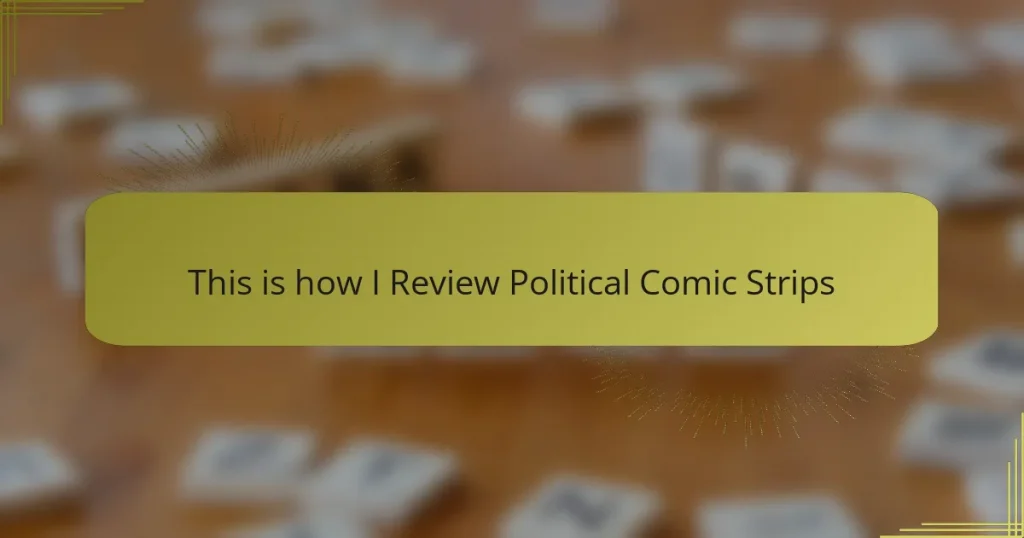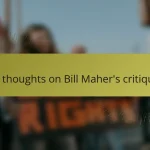Key takeaways
- Political comic strips blend humor and socio-political commentary, making complex issues more relatable and provoking thought.
- Political satire plays a critical role in shaping public discourse and encourages social engagement by providing a platform for discussion.
- Awards for political satire recognize the artistic talent and impact of comic strips, highlighting different categories like Best Political Cartoon and Most Impactful Commentary.
- Effective evaluation of comic strips considers humor, clarity of the message, and artistic style, all of which enhance the audience’s understanding and enjoyment.
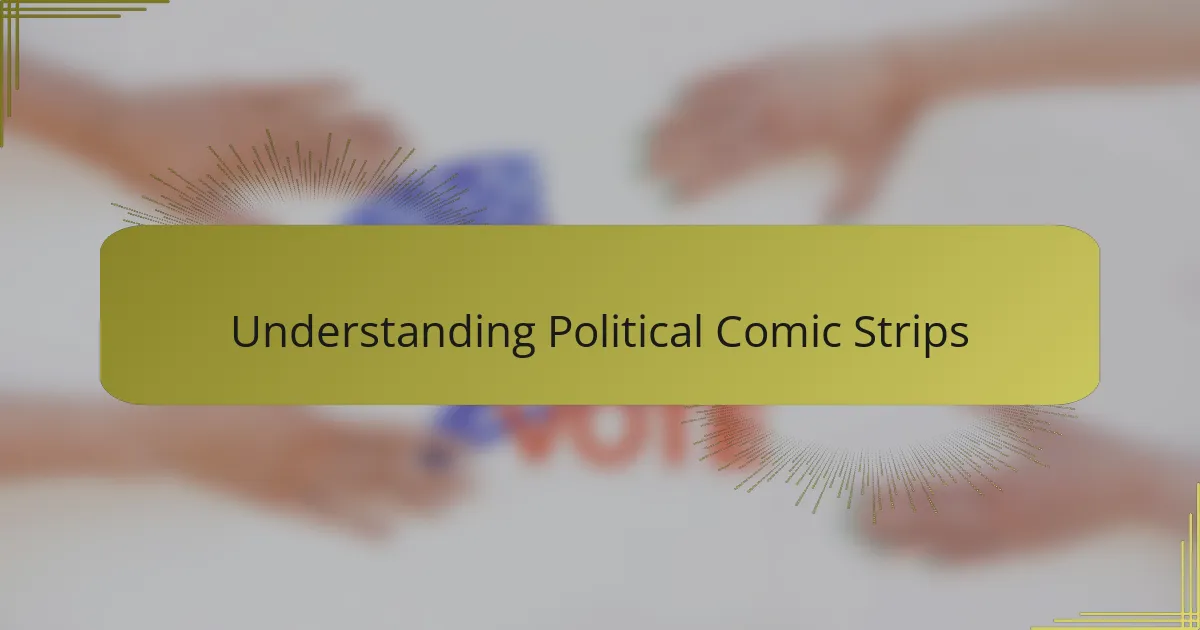
Understanding Political Comic Strips
Political comic strips are fascinating because they blend humor with socio-political commentary. From my experience, they often use satire to highlight current events, provoke thought, and sometimes stir controversy. A well-crafted comic strip can make complex issues more relatable and accessible, evoking laughter while also encouraging readers to reflect on serious matters.
I remember the first time a political comic strip really struck a chord with me. It was a cleverly drawn piece about a recent election. The humor was sharp, and it captured the absurdity of the political landscape, making me both chuckle and think deeply about the issues at hand. That’s the magic of political comic strips; they entertain while inviting us to consider the world around us.
Here’s a simple comparison of different styles of political comic strips:
| Style | Characteristics |
|---|---|
| Traditional | Often uses caricatures of politicians, focuses on humor and punchlines. |
| Editorial | Leans toward serious commentary, often with a poignant message or criticism. |
| Webcomics | Typically more experimental, may incorporate multimedia elements, often reaches a younger audience. |
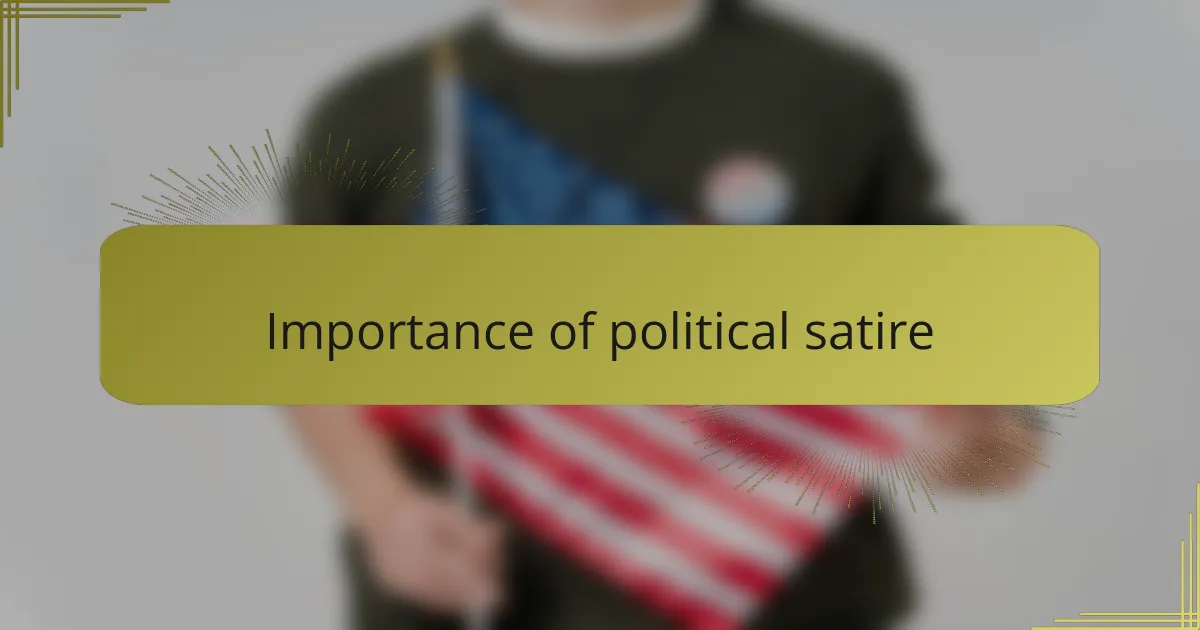
Importance of Political Satire
Political satire plays a vital role in shaping public discourse. In my view, it serves as a mirror reflecting society’s values, flaws, and absurdities. When I come across a witty comic strip, I often find myself questioning the status quo, realizing how humor can provoke a deeper understanding of complex political issues.
I’ve witnessed firsthand the power of political satire to break down barriers. A particularly impactful comic I encountered questioned the motives behind policy decisions in a light-hearted yet thought-provoking manner. It’s intriguing how humor can generate a sense of camaraderie among readers, uniting us through a shared understanding of our political landscape’s absurdities.
Moreover, political satire encourages social engagement. It provides a safe space for discussions that might otherwise feel too daunting. I remember sharing a comic strip with friends, sparking a lively conversation about the political climate—something we all felt strongly about, yet struggled to articulate. In essence, these strips help ensure that our political conversations remain vibrant and accessible.
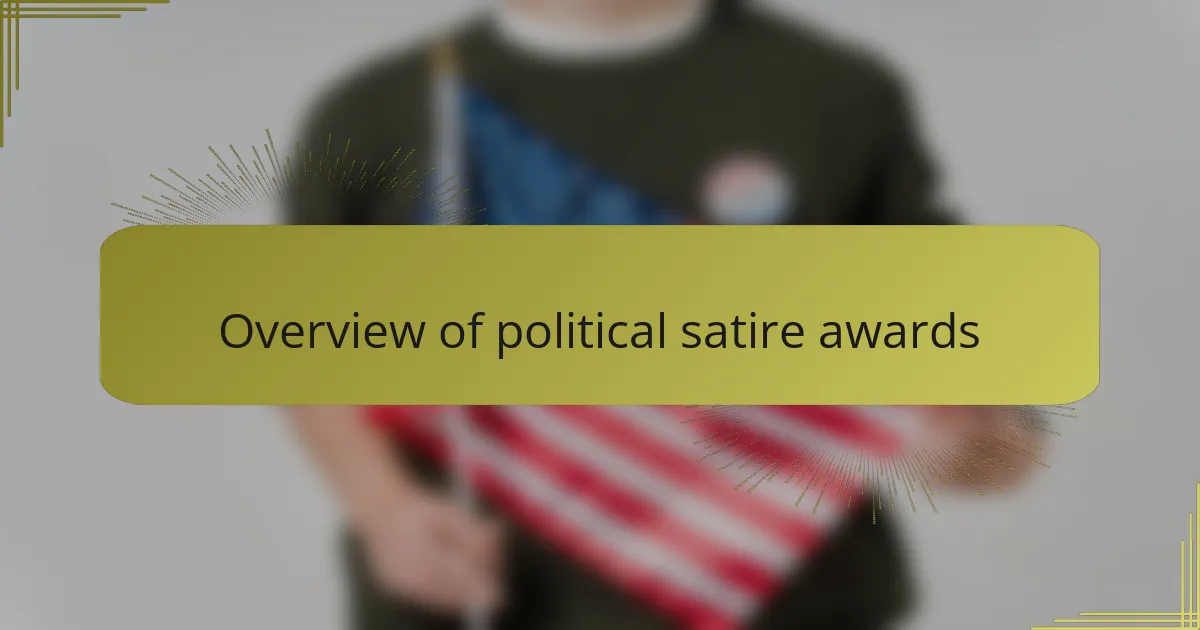
Overview of Political Satire Awards
Political satire awards celebrate the unique blend of humor and critique that comic strips provide in addressing societal issues. I’ve often found that these awards not only recognize the talent of the artists but also highlight the impact their work can have on public discourse. For instance, I vividly remember reading a comic strip that brilliantly captured the absurdities of a political scandal — it made me chuckle, yet I was left with a lingering thought about the seriousness of the context.
These awards typically encompass various categories that reflect the evolving landscape of politics and the artistic expression that critiques it. Here’s a summary of some common categories:
- Best Political Cartoon: Recognizes the overall excellence in humor and artistry.
- Most Impactful Commentary: Awards a strip that has sparked conversations or reflection among readers.
- Breakthrough Artist: Honors a newcomer whose work has shown potential and creativity in political satire.
- Lifetime Achievement: Acknowledges long-standing contributions to the field of political cartooning and satire.
- Audience Choice: Allows readers to vote for their favorite strips, emphasizing community engagement.
It’s these moments of laughter mixed with introspection that highlight the value of political satire in our lives.
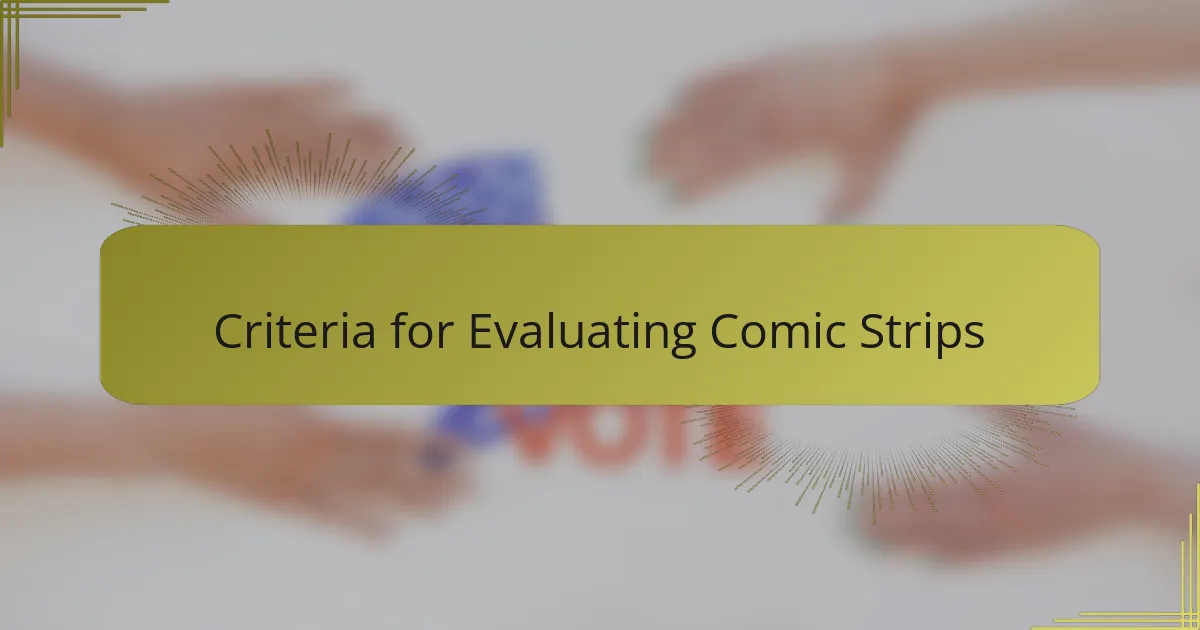
Criteria for Evaluating Comic Strips
When it comes to evaluating comic strips, one of the first criteria I consider is the effectiveness of the humor. Humor can take many forms, and it’s crucial that it resonates with the intended audience. I often ask myself, does the strip make me laugh out loud, or at least chuckle? A successful comic should elicit a genuine reaction while simultaneously highlighting a political issue. In my experience, the best ones strike a balance between cleverness and relatability.
Another key factor is the clarity of the message. I find it fascinating how even a single frame can convey complex ideas. Does the comic strip succinctly express a point of view, or does it leave me scratching my head? I remember a brilliant strip that tackled healthcare reform. The imagery was simple, yet it captured the essence of the debate, making it easy for readers to grasp the deeper implications. Clear messaging often determines a comic’s impact and longevity in the minds of its audience.
Lastly, the artistic style plays a significant role in evaluation. Each artist has a unique approach that adds layers to the narrative. I often ponder how the visual elements enhance or detract from the humor and message. For instance, I recently came across a comic with a minimalist style that brilliantly captured the chaos of a political rally. The simplicity allowed the punchline to shine through, proving that sometimes less really is more. What do you think? Does the style of a comic shape your interpretation of its message as much as its words?
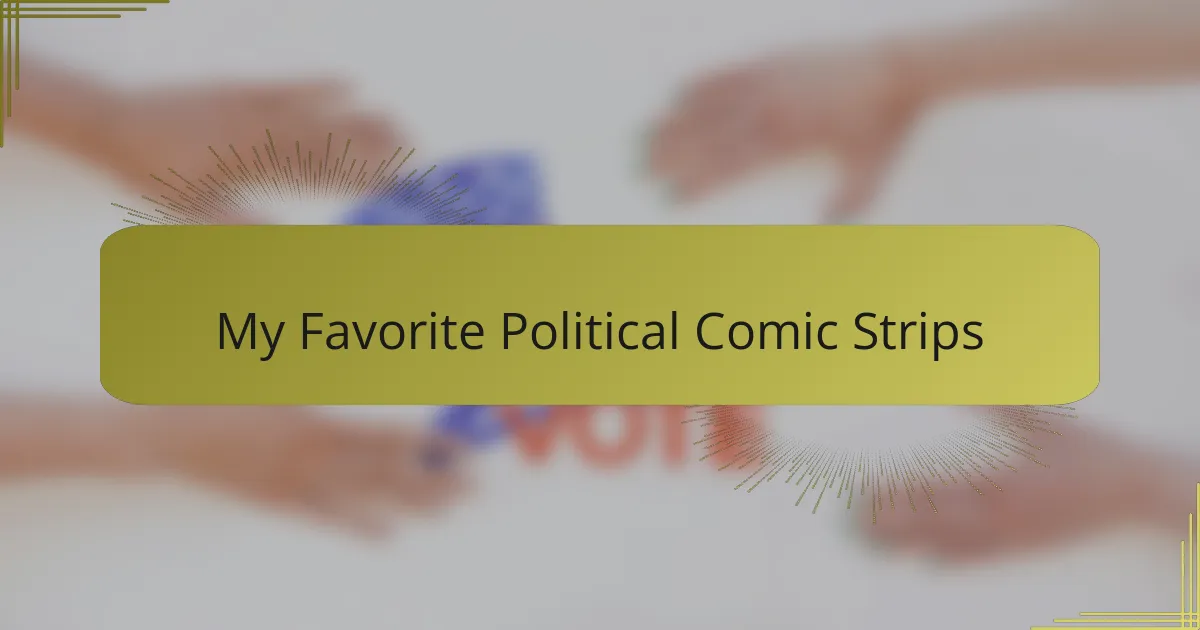
My Favorite Political Comic Strips
When I think about my favorite political comic strips, a few truly stand out. These are the ones that not only make me laugh but also provoke thought about current events and social issues. One that struck a chord with me recently was “Doonesbury.” I remember first discovering it in my college newspaper; it offered a blend of humor and insight that opened my eyes to political satire’s potential. This comic strip has a remarkable ability to punch up at powerful figures, making complex topics more digestible and relatable.
Another personal favorite is “The Boondocks.” I vividly recall sharing it with friends during discussions about race and politics. Aaron McGruder’s perspectives resonate deeply with my experiences and challenge my viewpoints, prompting meaningful conversations. The way he tackles difficult subjects with humor is something I admire and aspire to in my own writing.
- “Doonesbury” – Sharp social commentary wrapped in humor
- “The Boondocks” – Provocative and thought-provoking perspectives
- “Canadian Bacon” – A delightful parody that cleverly critiques political absurdity
- “Cathy” – A humorous take on everyday life that often reflects bigger societal issues
- “Get Fuzzy” – Uses wit to tackle topics like consumerism and media culture
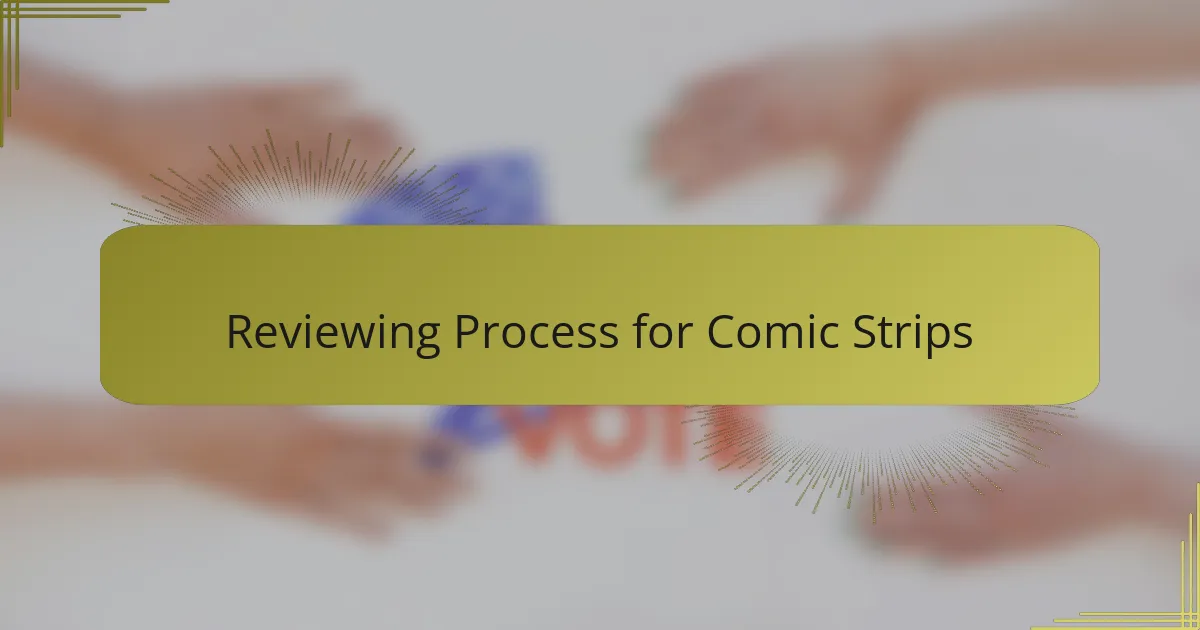
Reviewing Process for Comic Strips
The reviewing process for comic strips is multifaceted and often starts with a close reading of the content. I always engage with the strip on a personal level, reflecting on how the humor aligns with the political commentary it presents. Does it make me laugh? That initial reaction is crucial because laughter often paves the way for deeper reflection on serious issues.
Next, I analyze the artistry behind the strip. This involves thinking about how the visuals complement the message. For example, I remember reviewing a comic where the exaggerated expressions of the characters intensified the humor while effectively highlighting the absurdity of the situation. How does the style of the drawings interact with the theme? It’s fascinating to see how artists use visual storytelling to deepen our understanding of political nuances.
Additionally, I consider the comic’s context—knowing when and why it was created can add layers of meaning. I recall a particular strip that referenced a political scandal at the time. Understanding the background allowed me to appreciate the wit fully. It made me question broader societal attitudes while showcasing the strip’s relevance. Isn’t it intriguing how a few frames can encapsulate the zeitgeist of a moment?
